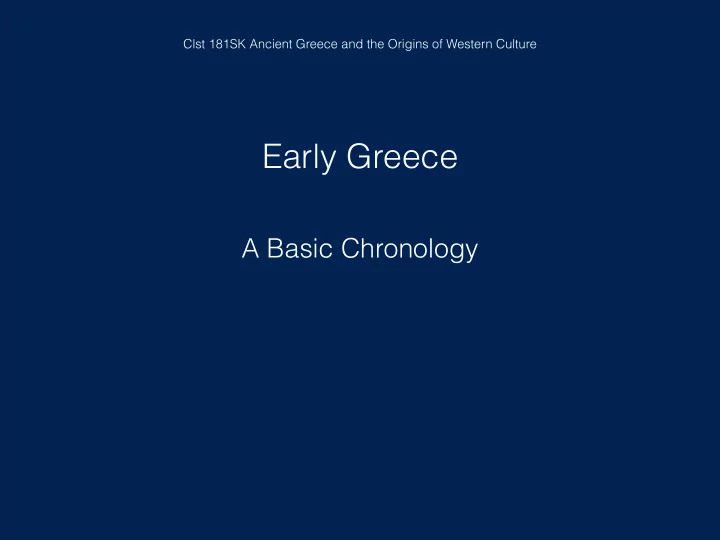

Clst 181SK Ancient Greece and the Origins of Western Culture Early Greece A Basic Chronology
1a. Bronze Age Greece - Minoans The Minoan Civilization (1900-1450 BCE) � � Knossos, Crete
1b. Bronze Age Greece - Mycenaeans The Mycenaean Civilization (1450-1200 BCE) Mainland Greece, especially the Peloponnesus Mycenae – Palace Megaron
Mycenae – Demons?
The Bronze Age - Collapse � Greek Palace structures are destroyed in about 1200-1150 BCE � Knossos Mycenae Pylos Thebes Tiryns Troy(!) We do not know how or by whom the devastation occurred - the Greeks told a story of invaders (the “Dorian invasion”)
2. The Greek “Dark Age” - the Iron Age � 1200-800 BCE Lefkandi – Heroön plan
� 2. The Iron Age 1200-750 BCE Early Geometric Vase 850 BCE
� 3. The Archaic Period 750-480 BCE 530 BCE 750 BCE 560 BCE 700 BCE 600 BCE
Clst 181SK Ancient Greece and the Origins of Western Culture Early Greece A Basic Chronology � 1a. Bronze Age - Minoans 1900-1450 BCE 1b. Bronze Age - Mycenaeans 1450-1200 2. Iron Age (Dark Ages) 1200-750 3. Archaic Period 750-480 � “Trojan War” - 1250-1200 BCE Collapse of Bronze Age palace system - 1200-1150 BCE Homer’s Iliad and Odyssey - 800-750 BCE
Early Greece “Trojan War” - 1250-1200 BCE Collapse of Bronze Age palace system - 1200-1150 BCE Homer’s Iliad and Odyssey - 800-750 BCE Question: which early Greece does Homer’s Iliad assume? The Bronze Age era of palaces or the Iron Age era sometimes known as the Dark Ages?
� The Trojan War: The Heroes Note: Ilium or Ilias is another name for Troy , thus the Iliad means the story of the war against Troy
� Mycenae (Mycene)
Review: Mesopotamia,Phoenicia, Crete, Cyprus, Delphi, Peloponnesus, Ionia
Review: Knossos, Mycenae, Pylos
Mycenae – aerial view
Lion’s gate reconstruction
Mycenae – Demons? Mycenae – Palace Megaron
Mycenae – gold cup
Stories of Mycenae: Background MYCENAE Pelops _____|______ Atreus Thyestes | | Agamemnon Menelaus Aigisthos SPARTA � Tyndareus = Leda = Zeus | | Klytaimnestra Helen Themes: Child murder, adultery, deception
� Mycenae (Mycene) Stories of Mycenae: Background Agamemnon , the son of Atreus Menelaus , the son of Atreus Mycenae: The “House of Atreus” Atreus and Thyestes : adultery, child murder
Stories of Mycenae: Background Menelaus , the son of Atreus King of Sparta His wife is Helen , the “face that launched a thousand ships” Helen is the the most beautiful woman in the world, said to be the daughter of Zeus and Leda Paris = Alexander , prince of Troy, son of Priam the Trojan King: seduction, adultery, violation
Stories of Mycenae: Background Helen , the “face that launched a thousand ships” Helen’s suitors were all the great heroes of Greece, and before she made her choice (Menelaus, of the house of Atreus) they made a treaty always to protect her husband from other suitors. Thus, when Paris seduced her and took her off to Troy, all the heroes were sworn to come to help the sons of Atreus, Menelaus and Agamemnon, as they sailed to Troy to get her back.
Stories of Mycenae: Background Agamemnon , the son of Atreus King of Mycenae His wife is Klytaimnestra/Clytemnestra � Klytaimnestra is the half sister of Helen, the daughter of Leda but not the daughter of Zeus
Stories of Mycenae: Background Agamemnon , the son of Atreus King of Mycenae His daughter is Iphigeneia/Iphigenia
Stories of Mycenae: Background The heroes and troops gather at Aulis to prepare for the voyage to Troy. But the winds blow against them, and day after day after day they cannot sail. The troops grow weary, hungry, rebellious. They ask the prophet (seer) Kalchas / Calchas what to do. He tells them that they have violated Artemis , the virgin goddess of the hunt To appease her, Kalchas says, the goddess asks a great price. They must sacrifice a girl, a virgin, the daughter of the King of kings, Agamemnon , the son of Atreus
Stories of Mycenae: Background Agamemnon curses Kalchas, but sends to his wife Klytaimnestra a messenger, telling her that their daughter, Iphigeneia/Iphigenia is to marry a great hero, � Achilles , son of Peleus and to send Iphigenia at once.
Stories of Mycenae: Background Klytaimnestra sends Iphigenia and Agamemnon performs a human sacrifice to Artemis of his own child. The winds turn, and the troops now sail to glorious battle at Troy. When Klytaimnestra learns what has happened, she joins forces (and body) with Aigisthos/ Aegisthus, the son of Thyestes (Agamemnon’s first cousin) and plots her revenge. She will murder Agamemnon when he returns at the end of the war.
Stories of Mycenae: Background MYCENAE Pelops _____|______ Atreus Thyestes | | Agamemnon Menelaus Aigisthos SPARTA � Tyndareus = Leda = Zeus | | Klytaimnestra Helen Themes: Child murder, adultery, deception
� The Trojan War: The Gods Note: the Greek gods live on mythical Mt Olympus.
ZEUS Sky God. King of the Gods. Son of Kronos.
HERA Married Women. Queen of the gods. Zeus’ “wife”.
APOLLO Archer god. God of plague and medicine. God of music and arts. Sister is Artemis, also an archer god.
HEPHAISTOS Smithy god (blacksmith). God of crafts and fire.
THETIS (one of the Nereids, the 50 daughters of Nereus, the old man of the sea; mother of Achilles by Peleus)
Judgement of Paris Paris, son of Priam decides “who is the fairest of them all” Hera, Athena, Aphrodite
Homer: The Gods � � Trojan supporters � •Aphrodite (won the judgement of Paris) •Ares (lover of Aphrodite, rival of Athena) •Apollo (traditional friend of Troy) •Artemis (sister of Apollo) •Scamander (river of the Troad, fights Hephaistos) •Leto (mother of Apollo and Artemis) � Greek supporters � •Hera (lost the judgement of Paris) •Athena (lost the judgement of Paris) •Poseidon (traditional friend of Troy, but denied payment by Laomedon after building the walls: but he helps Aeneas in Book 20) •Hephaistos (friend of Thetis) •Hermes (fights Leto) � http://people.duke.edu/~wj25/Greek_Originals/ Iliad_Summaries.html
� Iliad: the Proem
Recommend
More recommend